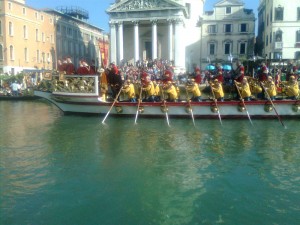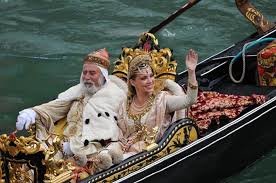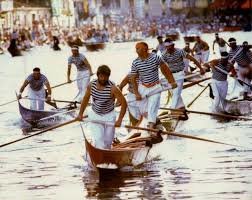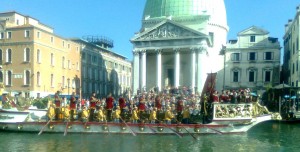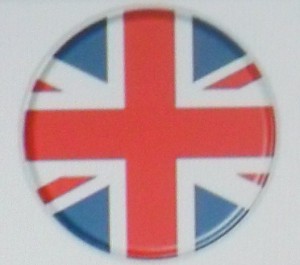The international word ,regatta, comes from the Latin word aurigare – term used with the sense of race, which the venetians used with the sense of racing on boats.Every year,on the first Sunday of September, you can see along
the Grand Canal the regatta of Venice ,who is composed of two distinct phases : the historical parade and competitive regattas.
The first races are related to the “feast of Marie” (tradition says that some pirates kidnapped the young Venetian girls. Were soon chased by men who rowed furiously on their boats ,reached the pirates and free the young girls) .
But is possible that the race had even older roots. http://dipoco.altervista.org/venice-carnival-marys-feast-days/
The races
Initially disputed on galleys, peatoni, barges, or agile boats with two or more rowing, today the four competitions are divided by age categories and by type of boat.It starts from the gardens of Santa Elena from the starting cord, called “spaghetti”and continue along the Grand Canal to the trainstation “Saint Lucia” where they turn around a stake driven into the middle of the Grand Canal. Then they return to the “machine”, a floating building situated in front of Ca ‘Foscari palace. In the past, the competition between boats took place in the section between the Lido island and Piazza San Marco.
Lalbo d’oro (the roll of honor) of the race refers to the winners of the competition. The prizes consist of money and flags, which replace the medals: red for first place, White for the second, (in the past it was celestial) for third place green, and blue for last.
The last flag was initially yellow with a pig painted, (considered a very little fast animal) and the quarter place was granted with a pig alive. Its passage between the boats and spectators was a “thermometer of the Venetians to the government of the city”, and when these were not the most satisfying,the pig was acclaimed with whistles and shouts of “here is the mayor, long live the Mayor.” Is replaced on 2002 with a pig in Murano glass.
The historical procession.
Is the parade of multi-colored sixteenth century boats, with gondoliers in period costume, carrying the Doge,the Dogaressa, Caterina Cornaro, and all the magistrates and important people of Venice.
Commemorates the welcome given in 1489 to Caterina Cornaro, wife of the King of Cyprus, who gave up her throne in favor of Venice.
In 1472 the eighteen year old Catherine goes to Famagusta, on the island of Cyprus, where the lavish wedding were celebrated . A year after the king died leaving pregnant the young widow. The following year his son died of malarial fever. Just twenty years she is crowned Queen of Cyprus. She remains on the island until 1489, when, at the request of the Venetian government, abdicate and return home.
Cyprus remained under the jurisdiction of the republic of Venice .She was awarded the title of “Adopted Daughter of the Republic” .It was appointed lady of Asolo, where he had the same powers as the Doge, calling at court poets and writers of the century: Giorgione, Lorenzo Lotto , Pietro Bembo. She became so famous that Titian painted her in a famous portrait.
Ca ‘Corner della Regina, built by the family of Catherine, is located near the Santa Croce district and overlooks the Grand Canal.
Once,the bissone,the boat that open the parade, goes on the back of the boat race. On board, the patricians with bows , shooting balls of clay (balote) to punish the most undisciplined participants of the race.
other items: http://dipoco.altervista.org/see-other-items/

